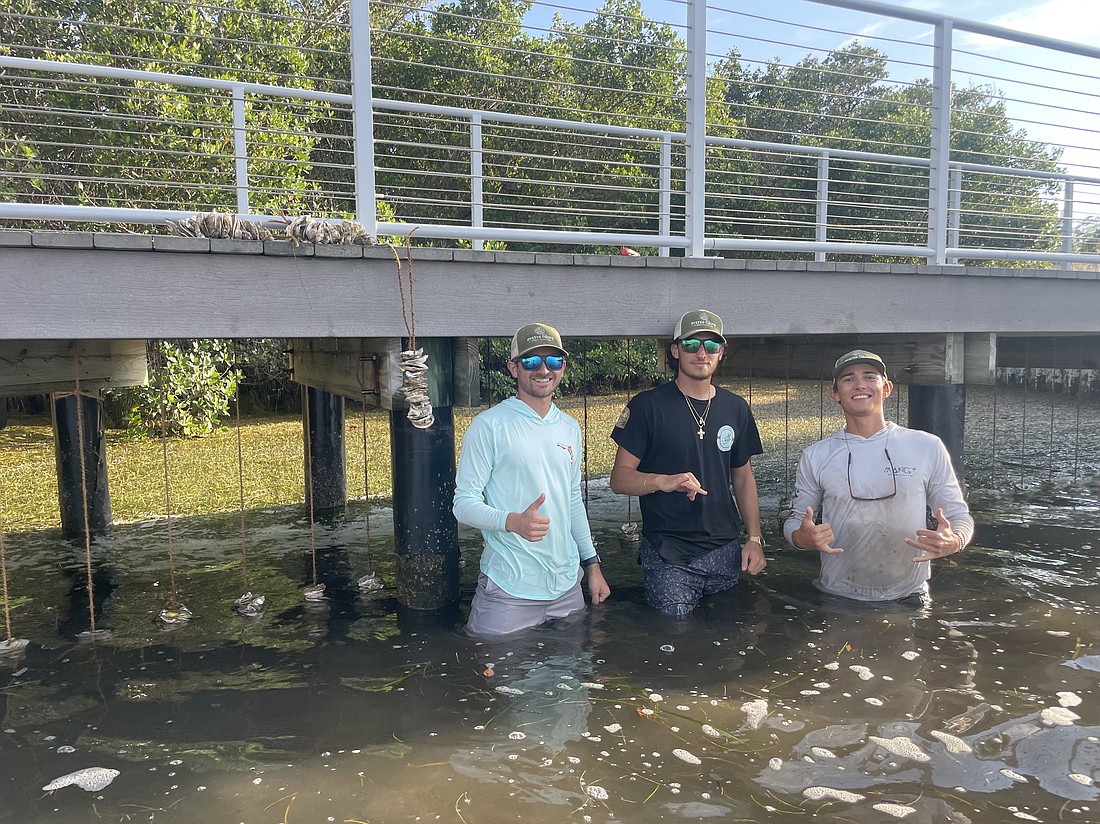- January 4, 2025
-
-
Loading

Loading

The strings of oyster shells hanging from the docks at Bayfront Park may not look like much now. But over the next few years, those simple structures could evolve into hubs for crucial filter feeder organisms.
Forty vertical Oyster Gardens were installed by Oyster Boys Conservation on June 2. The project is one of Longboat Key’s latest green initiatives in collaboration with the Sarasota Bay Estuary Program. The town has been partnered with SBEP for over three decades, according to the organization's executive director, David Tomasko.
Each VOG contains 20 recycled oyster shells, meaning the project at Bayfront Park brought a total of 800 oyster shells. Oyster larvae tend to grow on existing oysters, so the goal of VOGs is to promote the recruitment of oyster larvae and other organisms such as sponges and fish.
“These vertical oyster gardens are a great way to get more habitat complexity, and also to have a little bit more filter feeders in the water,” Tomasko said.
Oysters are a common filter feeder, making them an important part of the marine ecosystem. According to the National Oceanic and Atmospheric Administration, a single adult oyster can filter up to 50 gallons of water a day. Oysters are able to remove pollutants in the ecosystem, thus improving water quality. Oysters are also sessile organisms, meaning once they attach to a surface they remain there for their entire adult life.
Developed areas like Longboat Key pose a problem — not everywhere has a natural shoreline. Seawalls are good for protecting properties but lack the ability to enhance the biodiversity of an area because of their flat metal surface. Projects like VOGs are a good way to stimulate an environment while also realizing that the conditions may not always be the most ideal.
“We’re trying to deal with it as it is, not as we’d love it to be,” Tomasko said.
Carolyn Brown, support services director for Longboat Key, said a group of residents that have a strong environmental interest brought forth the idea of VOGs. This recommendation complemented the town’s overarching sustainability goals, according to Brown.
“The town wants to make an impression, wants to do the right thing and be somewhat of a leader to the extent that we can,” Brown said.
The VOG projects hit two out of the four main goals outlined in SBEP’s Comprehensive Conservation and Management Plan: Wildlife Action Plan and Community Engagement Action Plan.
The first is simple. The oyster gardens at Bayfront Park are intended to increase the abundance of marine organisms in the waters nearby.
“Anything we do to increase the complexity of this kind of shoreline is going to be good and anything we can do to get more filter feeders in the bay is good,” Tomasko said.
Second, Tomasko hopes that through more public engagement, others will be encouraged to implement oyster gardens on their own docks.
“Our goal is not to have dozens of these things out there, our goal is to have thousands of these out there and maybe tens of thousands,” Tomasko said.
Brown said the town is hoping to continue working closely with SBEP on upcoming projects. This sentiment was shared by Tomasko. He hinted at possible projects such as softening shorelines in the area and implementing a type of panel that attaches to seawalls and could effectively allow filter feeders to grow on that surface.
Above all, environmental efforts are not the responsibility of a single entity, Tomasko said. According to him, local and national governments are important driving forces that have already committed to spending “almost a billion dollars on wastewater upgrades and stormwater retrofits” to improve environmental quality. Smaller projects like VOGs can be a way for residents to get involved.
“We need the average homeowner who lives along the waterfront to do their part,” Tomasko said.
Brown said environmental projects like the ones described by Tomasko may begin as early as the next fiscal year.
“We think it’s everyone’s responsibility to preserve the environment for future generations,” Brown said. “It’s important while we’re all here to be respectful of the environment, to take care of it and to do whatever we can to mitigate any impacts.”